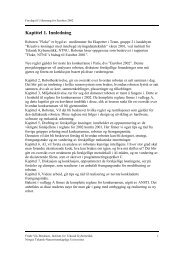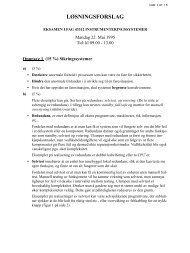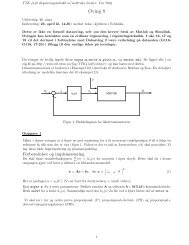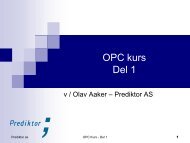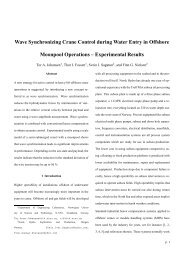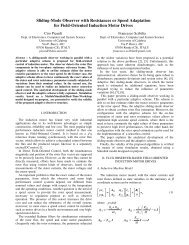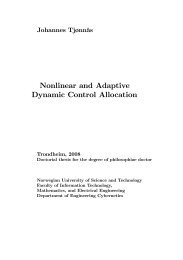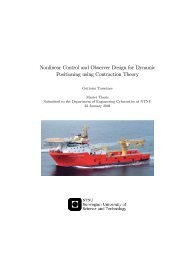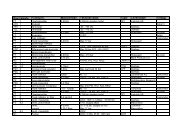Optimal time control for reservoir optimization - NTNU
Optimal time control for reservoir optimization - NTNU
Optimal time control for reservoir optimization - NTNU
You also want an ePaper? Increase the reach of your titles
YUMPU automatically turns print PDFs into web optimized ePapers that Google loves.
<strong>Optimal</strong> <strong>time</strong> <strong>control</strong> <strong>for</strong> <strong>reservoir</strong><br />
<strong>optimization</strong><br />
Agus Hasan and Bjarne Foss<br />
Department of Engineering Cybernetics <strong>NTNU</strong><br />
IO-Center <strong>NTNU</strong><br />
October 31, 2012<br />
1 Smart Field Annual Meeting 2012, Stan<strong>for</strong>d University <strong>Optimal</strong> <strong>time</strong> <strong>control</strong> <strong>for</strong> <strong>reservoir</strong> <strong>optimization</strong>
IO-Center <strong>NTNU</strong><br />
IO-Center Collaborators<br />
2 Smart Field Annual Meeting 2012, Stan<strong>for</strong>d University <strong>Optimal</strong> <strong>time</strong> <strong>control</strong> <strong>for</strong> <strong>reservoir</strong> <strong>optimization</strong>
IO-Center <strong>NTNU</strong><br />
On going projects on production <strong>optimization</strong><br />
Short-term <strong>optimization</strong><br />
Production Optimization at Marlim Field (MINLP) → Vidar Gunnerud,<br />
Petrobras.<br />
Dual Control and MPC → Tor Aksel N. Heirung, Carnegie Mellon University.<br />
Trustworthy Production Optimization → Bjarne Grimstad, BP.<br />
Dynamics Production Optimization of Oil Fields at Urucu → Andres Codas<br />
Duarte, Kongsberg.<br />
Long-term <strong>optimization</strong><br />
Joining Well Placement and Well Control Decisions → Mathias Bellout,<br />
Stan<strong>for</strong>d University, IBM, Total.<br />
Optimization of Late-life Shale-well Systems → Brage Rugstad Knudsen,<br />
Carnegie Mellon University, Statoil, IBM.<br />
Optimization and Control of Petroleum Reservoir (Voador and Troll Field) →<br />
Agus Hasan, SINTEF, Statoil, Petrobras.<br />
The Norne Benchmark → Richard Rwechungura, Statoil.<br />
Long-term and Short-term <strong>optimization</strong><br />
Incorporating Long-term and Short-term Production Optimization →<br />
Mansoureh Jesmani.<br />
Completed projects<br />
Gradient-based Methods <strong>for</strong> Production Optimization of Oil Reservoirs → Eka<br />
Suwartadi, SINTEF.<br />
Integrated Field Modeling and Optimization → Silvya Rahmawati, PERA AS.<br />
3 Smart Field Annual Meeting 2012, Stan<strong>for</strong>d University <strong>Optimal</strong> <strong>time</strong> <strong>control</strong> <strong>for</strong> <strong>reservoir</strong> <strong>optimization</strong>
IO-Center <strong>NTNU</strong><br />
SPE-Applied Technical Workshop 2013<br />
Title : Integrated 4D Seismic & Production Data <strong>for</strong> Reservoir Management –<br />
Application to Norne (Norway)<br />
Place : Radisson BLU Royal Garden Hotel, Trondheim Norway<br />
Time : 25th – 27th June 2013<br />
Comparative case study<br />
To utilize production and 4D seismic data from the full field Norne<br />
Data, http://www.ipt.ntnu.no/~norne/, Package 2 Full Field Model 2013.<br />
Exercise Description to include data integration<br />
To utilize more seismic data<br />
4 Smart Field Annual Meeting 2012, Stan<strong>for</strong>d University <strong>Optimal</strong> <strong>time</strong> <strong>control</strong> <strong>for</strong> <strong>reservoir</strong> <strong>optimization</strong>
Outline<br />
IO-Center <strong>NTNU</strong><br />
1 Introduction<br />
2 Reservoir and well model<br />
3 Gradient computation<br />
4 Numerical example<br />
5 Conclusions<br />
5 Smart Field Annual Meeting 2012, Stan<strong>for</strong>d University <strong>Optimal</strong> <strong>time</strong> <strong>control</strong> <strong>for</strong> <strong>reservoir</strong> <strong>optimization</strong>
CLRM<br />
Introduction<br />
6 Smart Field Annual Meeting 2012, Stan<strong>for</strong>d University <strong>Optimal</strong> <strong>time</strong> <strong>control</strong> <strong>for</strong> <strong>reservoir</strong> <strong>optimization</strong>
<strong>Optimal</strong> <strong>control</strong><br />
Introduction<br />
The optimal <strong>control</strong> problem may be stated in a canonical<br />
<strong>for</strong>m as follows<br />
max<br />
u<br />
J(u) = ψ(x(T )) +<br />
∫ T<br />
0<br />
L(x(t), u(t)) dt<br />
Subject to ẋ(t) = A(x(t))x(t) + B(x(t))u(t)<br />
x(0) = ¯x 0<br />
u(t) ∈ U, ∀t ∈ [0, T ]<br />
✁ ✁✕ U = {q ∈ R m : u min ≤ q ≤ u max }<br />
✁<br />
✁ ✁<br />
Control Input<br />
7 Smart Field Annual Meeting 2012, Stan<strong>for</strong>d University <strong>Optimal</strong> <strong>time</strong> <strong>control</strong> <strong>for</strong> <strong>reservoir</strong> <strong>optimization</strong>
<strong>Optimal</strong> <strong>control</strong><br />
Introduction<br />
The optimal <strong>control</strong> problem may be stated in a canonical<br />
<strong>for</strong>m as follows<br />
max<br />
u<br />
J(u) = ψ(x(T )) +<br />
∫ T<br />
0<br />
L(x(t), u(t)) dt<br />
Subject to ẋ(t) = A(x(t))x(t) + B(x(t))u(t)<br />
x(0) = ¯x 0<br />
u(t) ∈ U, ∀t ∈ [0, T ]<br />
✁ ✁✕ U = {q ∈ R m : u min ≤ q ≤ u max }<br />
✁<br />
✁ ✁<br />
Control Input<br />
7 Smart Field Annual Meeting 2012, Stan<strong>for</strong>d University <strong>Optimal</strong> <strong>time</strong> <strong>control</strong> <strong>for</strong> <strong>reservoir</strong> <strong>optimization</strong>
Motivation<br />
Introduction<br />
u<br />
✻<br />
1<br />
✻<br />
❄<br />
∂J<br />
=? ∂u<br />
✻<br />
❄<br />
0<br />
✻<br />
t 1<br />
❄<br />
t 2<br />
✲<br />
t<br />
8 Smart Field Annual Meeting 2012, Stan<strong>for</strong>d University <strong>Optimal</strong> <strong>time</strong> <strong>control</strong> <strong>for</strong> <strong>reservoir</strong> <strong>optimization</strong>
Motivation<br />
Introduction<br />
u<br />
✻<br />
1<br />
✻<br />
❄<br />
∂J<br />
=? ∂u<br />
✻<br />
❄<br />
0<br />
✻<br />
t 1<br />
❄<br />
t 2<br />
✲<br />
t<br />
8 Smart Field Annual Meeting 2012, Stan<strong>for</strong>d University <strong>Optimal</strong> <strong>time</strong> <strong>control</strong> <strong>for</strong> <strong>reservoir</strong> <strong>optimization</strong>
Motivation<br />
Introduction<br />
u<br />
✻<br />
1<br />
✻<br />
❄<br />
∂J<br />
=? ∂u<br />
✻<br />
❄<br />
0<br />
✻<br />
t 1<br />
❄<br />
t 2<br />
✲<br />
t<br />
8 Smart Field Annual Meeting 2012, Stan<strong>for</strong>d University <strong>Optimal</strong> <strong>time</strong> <strong>control</strong> <strong>for</strong> <strong>reservoir</strong> <strong>optimization</strong>
Motivation<br />
Introduction<br />
u<br />
✻<br />
1<br />
0<br />
✛✲<br />
∂J<br />
∂J<br />
✛✲<br />
∂t 1<br />
=?<br />
∂t 2<br />
=?<br />
t 1 t 2<br />
✲<br />
t<br />
9 Smart Field Annual Meeting 2012, Stan<strong>for</strong>d University <strong>Optimal</strong> <strong>time</strong> <strong>control</strong> <strong>for</strong> <strong>reservoir</strong> <strong>optimization</strong>
Motivation<br />
Introduction<br />
u<br />
✻<br />
1<br />
0<br />
✛✲<br />
∂J<br />
∂J<br />
✛✲<br />
∂t 1<br />
=?<br />
∂t 2<br />
=?<br />
t 1 t 2<br />
✲<br />
t<br />
9 Smart Field Annual Meeting 2012, Stan<strong>for</strong>d University <strong>Optimal</strong> <strong>time</strong> <strong>control</strong> <strong>for</strong> <strong>reservoir</strong> <strong>optimization</strong>
Motivation<br />
Introduction<br />
u<br />
✻<br />
1<br />
0<br />
✛✲<br />
∂J<br />
∂J<br />
✛✲<br />
∂t 1<br />
=?<br />
∂t 2<br />
=?<br />
t 1 t 2<br />
✲<br />
t<br />
9 Smart Field Annual Meeting 2012, Stan<strong>for</strong>d University <strong>Optimal</strong> <strong>time</strong> <strong>control</strong> <strong>for</strong> <strong>reservoir</strong> <strong>optimization</strong>
Reservoir and well model<br />
State space representation<br />
The standard black oil <strong>for</strong>mulation <strong>for</strong> oil-water system may be written in<br />
the following PDE<br />
(<br />
∂<br />
∂t (φρ o[1 − s]) = ∇ · k k )<br />
ro<br />
ρ o ∇p + q o<br />
µ o<br />
(<br />
∂<br />
∂t (φρ ws) = ∇ · k k )<br />
rw<br />
ρ w ∇p + q w<br />
µ w<br />
Applying spatial discretization, the system may be written in the<br />
following ODE<br />
where<br />
ẋ(t) = A(x(t))x(t) + B(x(t))u(t)<br />
x(0) = ¯x 0<br />
u(t) = [q 1 (t) q 2 (t) · · · q Nw (t)] ⊺ ∈ R Nw<br />
10 Smart Field Annual Meeting 2012, Stan<strong>for</strong>d University <strong>Optimal</strong> <strong>time</strong> <strong>control</strong> <strong>for</strong> <strong>reservoir</strong> <strong>optimization</strong>
Reservoir and well model<br />
State space representation<br />
The standard black oil <strong>for</strong>mulation <strong>for</strong> oil-water system may be written in<br />
the following PDE<br />
(<br />
∂<br />
∂t (φρ o[1 − s]) = ∇ · k k )<br />
ro<br />
ρ o ∇p + q o<br />
µ o<br />
(<br />
∂<br />
∂t (φρ ws) = ∇ · k k )<br />
rw<br />
ρ w ∇p + q w<br />
µ w<br />
Applying spatial discretization, the system may be written in the<br />
following ODE<br />
where<br />
ẋ(t) = A(x(t))x(t) + B(x(t))u(t)<br />
x(0) = ¯x 0<br />
u(t) = [q 1 (t) q 2 (t) · · · q Nw (t)] ⊺ ∈ R Nw<br />
10 Smart Field Annual Meeting 2012, Stan<strong>for</strong>d University <strong>Optimal</strong> <strong>time</strong> <strong>control</strong> <strong>for</strong> <strong>reservoir</strong> <strong>optimization</strong>
Well model<br />
Reservoir and well model<br />
The <strong>control</strong>s are given by the Peaceman model<br />
q j (t) = α j (t)w j (s j )(p j R − pj bh (t)), j ∈ {N inj, N prod }<br />
where α j (t) ∈ {[0, 1]} denotes the settings of the on-off valves of well j.<br />
Linear relationship between q j and α j .<br />
The term q j (t) in u may be replaced by α j (t) and the<br />
corresponding entries in B are modified to include the term<br />
w j (s j )(p j R − pj bh (t)).<br />
11 Smart Field Annual Meeting 2012, Stan<strong>for</strong>d University <strong>Optimal</strong> <strong>time</strong> <strong>control</strong> <strong>for</strong> <strong>reservoir</strong> <strong>optimization</strong>
Well model<br />
Reservoir and well model<br />
The <strong>control</strong>s are given by the Peaceman model<br />
q j (t) = α j (t)w j (s j )(p j R − pj bh (t)), j ∈ {N inj, N prod }<br />
where α j (t) ∈ {[0, 1]} denotes the settings of the on-off valves of well j.<br />
Linear relationship between q j and α j .<br />
The term q j (t) in u may be replaced by α j (t) and the<br />
corresponding entries in B are modified to include the term<br />
w j (s j )(p j R − pj bh (t)).<br />
11 Smart Field Annual Meeting 2012, Stan<strong>for</strong>d University <strong>Optimal</strong> <strong>time</strong> <strong>control</strong> <strong>for</strong> <strong>reservoir</strong> <strong>optimization</strong>
Well model<br />
Reservoir and well model<br />
The <strong>control</strong>s are given by the Peaceman model<br />
q j (t) = α j (t)w j (s j )(p j R − pj bh (t)), j ∈ {N inj, N prod }<br />
where α j (t) ∈ {[0, 1]} denotes the settings of the on-off valves of well j.<br />
Linear relationship between q j and α j .<br />
The term q j (t) in u may be replaced by α j (t) and the<br />
corresponding entries in B are modified to include the term<br />
w j (s j )(p j R − pj bh (t)).<br />
11 Smart Field Annual Meeting 2012, Stan<strong>for</strong>d University <strong>Optimal</strong> <strong>time</strong> <strong>control</strong> <strong>for</strong> <strong>reservoir</strong> <strong>optimization</strong>
Gradient Computation<br />
Control parameterization<br />
The idea is to parameterize the valve settings into a piecewise constant<br />
function over the interval [0, T ] with switches at t j 1 , · · · , tj M j<br />
as follows<br />
M j<br />
∑<br />
α j (t) = γ j k χ [t j )(t), χ I(t) =<br />
k ,tj k+1<br />
k=0<br />
{<br />
1, t ∈ I<br />
0, otherwise<br />
The switching <strong>time</strong>s t j k , k = 1, · · · , M j may be distinguished such that<br />
0 = t j 0 < tj 1 < · · · < tj M j<br />
< t j M j+1<br />
= T<br />
Let’s define the switching vectors as<br />
v = [(t 1 1, · · · , t 1 M 1<br />
) ⊺ , · · · , (t Nw<br />
1 , · · · , t Nw<br />
} {{ } } {{ }<br />
v 1<br />
v Nw<br />
M Nw<br />
) ⊺ ] ⊺<br />
12 Smart Field Annual Meeting 2012, Stan<strong>for</strong>d University <strong>Optimal</strong> <strong>time</strong> <strong>control</strong> <strong>for</strong> <strong>reservoir</strong> <strong>optimization</strong>
Gradient Computation<br />
Gradient of the switching <strong>time</strong>s<br />
Theorem<br />
For each j = 1, · · · , N w, the gradient of the functional J with respect to v j is given<br />
by<br />
⎡<br />
H(x(t − 1 |v), u(t− 1 |v), λ(t− 1 |v))<br />
⎤<br />
−H(x(t + 1<br />
∂J(v)<br />
|v), u(t+ 1 |v), λ(t+ 1 |v))<br />
∂v j =<br />
.<br />
⎢<br />
⎣ H(x(t − M |v), u(t − j M |v), λ(t − j M |v)) ⎥<br />
j ⎦<br />
−H(x(t + M |v), u(t + j M |v), λ(t + j M |v))<br />
j<br />
where<br />
H(x(t), u(t), λ(t)) = L(x(t), u(t)) + λ ⊺ (A(x(t))x(t) + B(x(t))u(t))<br />
H(t + |v) = lim<br />
τ→t + H(τ|v)<br />
H(t − |v) = lim<br />
τ→t − H(τ|v)<br />
Computes the gradient w.r.t. switching <strong>time</strong>s efficiently.<br />
13 Smart Field Annual Meeting 2012, Stan<strong>for</strong>d University <strong>Optimal</strong> <strong>time</strong> <strong>control</strong> <strong>for</strong> <strong>reservoir</strong> <strong>optimization</strong>
Gradient Computation<br />
Applying heuristic search method - the halving<br />
interval method<br />
q<br />
✻<br />
1<br />
✛<br />
∂J<br />
∂t s<br />
< 0<br />
0<br />
t 0 t s t f<br />
✲<br />
t<br />
14 Smart Field Annual Meeting 2012, Stan<strong>for</strong>d University <strong>Optimal</strong> <strong>time</strong> <strong>control</strong> <strong>for</strong> <strong>reservoir</strong> <strong>optimization</strong>
Gradient Computation<br />
Applying heuristic search method - the halving<br />
interval method<br />
q<br />
✻<br />
1<br />
✛<br />
∂J<br />
∂t s<br />
< 0<br />
0<br />
t 0 t s t f<br />
✲<br />
t<br />
14 Smart Field Annual Meeting 2012, Stan<strong>for</strong>d University <strong>Optimal</strong> <strong>time</strong> <strong>control</strong> <strong>for</strong> <strong>reservoir</strong> <strong>optimization</strong>
Gradient Computation<br />
Applying heuristic search method - the halving<br />
interval method<br />
q<br />
✻<br />
1<br />
✛<br />
∂J<br />
∂t s<br />
< 0<br />
0<br />
t 0 t s t f<br />
✲<br />
t<br />
14 Smart Field Annual Meeting 2012, Stan<strong>for</strong>d University <strong>Optimal</strong> <strong>time</strong> <strong>control</strong> <strong>for</strong> <strong>reservoir</strong> <strong>optimization</strong>
Gradient Computation<br />
Applying heuristic search method - the halving<br />
interval method<br />
q<br />
✻<br />
1<br />
✛<br />
∂J<br />
∂t s<br />
< 0<br />
0<br />
t 0 t s t f<br />
✲<br />
t<br />
14 Smart Field Annual Meeting 2012, Stan<strong>for</strong>d University <strong>Optimal</strong> <strong>time</strong> <strong>control</strong> <strong>for</strong> <strong>reservoir</strong> <strong>optimization</strong>
Gradient Computation<br />
Applying heuristic search method - the halving<br />
interval method<br />
q<br />
✻<br />
1<br />
0<br />
t 0 t s t f<br />
✲<br />
t<br />
15 Smart Field Annual Meeting 2012, Stan<strong>for</strong>d University <strong>Optimal</strong> <strong>time</strong> <strong>control</strong> <strong>for</strong> <strong>reservoir</strong> <strong>optimization</strong>
Gradient Computation<br />
Applying heuristic search method - the halving<br />
interval method<br />
q<br />
✻<br />
1<br />
0<br />
t 0 t s t f<br />
✲<br />
t<br />
16 Smart Field Annual Meeting 2012, Stan<strong>for</strong>d University <strong>Optimal</strong> <strong>time</strong> <strong>control</strong> <strong>for</strong> <strong>reservoir</strong> <strong>optimization</strong>
Gradient Computation<br />
Applying heuristic search method - the halving<br />
interval method<br />
q<br />
✻<br />
1<br />
0<br />
∂J<br />
∂t s<br />
> 0 ✲<br />
t 0 t s t f<br />
✲<br />
t<br />
17 Smart Field Annual Meeting 2012, Stan<strong>for</strong>d University <strong>Optimal</strong> <strong>time</strong> <strong>control</strong> <strong>for</strong> <strong>reservoir</strong> <strong>optimization</strong>
Gradient Computation<br />
Applying heuristic search method - the halving<br />
interval method<br />
q<br />
✻<br />
1<br />
0<br />
∂J<br />
∂t s<br />
> 0 ✲<br />
t 0 t s t f<br />
✲<br />
t<br />
17 Smart Field Annual Meeting 2012, Stan<strong>for</strong>d University <strong>Optimal</strong> <strong>time</strong> <strong>control</strong> <strong>for</strong> <strong>reservoir</strong> <strong>optimization</strong>
Gradient Computation<br />
Applying heuristic search method - the halving<br />
interval method<br />
q<br />
✻<br />
1<br />
0<br />
∂J<br />
∂t s<br />
> 0 ✲<br />
t 0 t s t f<br />
✲<br />
t<br />
17 Smart Field Annual Meeting 2012, Stan<strong>for</strong>d University <strong>Optimal</strong> <strong>time</strong> <strong>control</strong> <strong>for</strong> <strong>reservoir</strong> <strong>optimization</strong>
Gradient Computation<br />
Applying heuristic search method - the halving<br />
interval method<br />
q<br />
✻<br />
1<br />
0<br />
t 0<br />
t s<br />
t f<br />
✲<br />
t<br />
18 Smart Field Annual Meeting 2012, Stan<strong>for</strong>d University <strong>Optimal</strong> <strong>time</strong> <strong>control</strong> <strong>for</strong> <strong>reservoir</strong> <strong>optimization</strong>
Gradient Computation<br />
Applying heuristic search method - the halving<br />
interval method<br />
q<br />
✻<br />
1<br />
0<br />
t 0<br />
t s<br />
t f<br />
✲<br />
t<br />
19 Smart Field Annual Meeting 2012, Stan<strong>for</strong>d University <strong>Optimal</strong> <strong>time</strong> <strong>control</strong> <strong>for</strong> <strong>reservoir</strong> <strong>optimization</strong>
Gradient Computation<br />
Applying heuristic search method - the halving<br />
interval method<br />
q<br />
✻<br />
1<br />
✛<br />
∂J<br />
∂t s<br />
< 0<br />
0<br />
t 0<br />
t s<br />
t f<br />
✲<br />
t<br />
20 Smart Field Annual Meeting 2012, Stan<strong>for</strong>d University <strong>Optimal</strong> <strong>time</strong> <strong>control</strong> <strong>for</strong> <strong>reservoir</strong> <strong>optimization</strong>
Gradient Computation<br />
Applying heuristic search method - the halving<br />
interval method<br />
q<br />
✻<br />
1<br />
✛<br />
∂J<br />
∂t s<br />
< 0<br />
0<br />
t 0<br />
t s<br />
t f<br />
✲<br />
t<br />
20 Smart Field Annual Meeting 2012, Stan<strong>for</strong>d University <strong>Optimal</strong> <strong>time</strong> <strong>control</strong> <strong>for</strong> <strong>reservoir</strong> <strong>optimization</strong>
Gradient Computation<br />
Applying heuristic search method - the halving<br />
interval method<br />
q<br />
✻<br />
1<br />
✛<br />
∂J<br />
∂t s<br />
< 0<br />
0<br />
t 0<br />
t s<br />
t f<br />
✲<br />
t<br />
20 Smart Field Annual Meeting 2012, Stan<strong>for</strong>d University <strong>Optimal</strong> <strong>time</strong> <strong>control</strong> <strong>for</strong> <strong>reservoir</strong> <strong>optimization</strong>
Gradient Computation<br />
Applying heuristic search method - the halving<br />
interval method<br />
q<br />
✻<br />
1<br />
0<br />
t 0<br />
t s<br />
t f<br />
✲<br />
t<br />
21 Smart Field Annual Meeting 2012, Stan<strong>for</strong>d University <strong>Optimal</strong> <strong>time</strong> <strong>control</strong> <strong>for</strong> <strong>reservoir</strong> <strong>optimization</strong>
Gradient Computation<br />
Applying heuristic search method - the halving<br />
interval method<br />
q<br />
✻<br />
1<br />
0<br />
t 0<br />
t s<br />
t f<br />
✲<br />
t<br />
22 Smart Field Annual Meeting 2012, Stan<strong>for</strong>d University <strong>Optimal</strong> <strong>time</strong> <strong>control</strong> <strong>for</strong> <strong>reservoir</strong> <strong>optimization</strong>
Simulation<br />
Numerical example - Objective function<br />
Suppose the aim is to<br />
max<br />
v<br />
J NP V =<br />
⎛<br />
⎞<br />
∫ T<br />
⎝<br />
∑<br />
r o(t)qo j (t) −<br />
∑<br />
rw p qj w (t) +<br />
∑<br />
rw i qj w (t) ⎠<br />
0<br />
j∈N prod j∈N prod j∈N inj<br />
1<br />
× ( ) ct dt<br />
1 + I<br />
100<br />
subject to the dynamical systems and <strong>control</strong> constraint.<br />
23 Smart Field Annual Meeting 2012, Stan<strong>for</strong>d University <strong>Optimal</strong> <strong>time</strong> <strong>control</strong> <strong>for</strong> <strong>reservoir</strong> <strong>optimization</strong>
Reservoir Model<br />
Simulation<br />
Figure: Grid and wells positions. Figure: Permeability distribution.<br />
ref: K.-A. Lie, et.al., Open source MATLAB implementation of consistent<br />
discretisations on complex grids, Comput. Geosci., Vol. 16, No. 2, pp. 297-322, 2012.<br />
24 Smart Field Annual Meeting 2012, Stan<strong>for</strong>d University <strong>Optimal</strong> <strong>time</strong> <strong>control</strong> <strong>for</strong> <strong>reservoir</strong> <strong>optimization</strong>
Reservoir Data<br />
Simulation<br />
Parameters Value Unit<br />
qw, j j ∈ N inj 500 m 3 /day<br />
rw i −63 USD/m 3<br />
ro p 630 USD/m 3<br />
rw p 63 USD/m 3<br />
I 10 %<br />
µ o 5 × 10 −3 Pa · s<br />
µ w 1 × 10 −3 Pa · s<br />
ρ o 859 kg/m 3<br />
ρ w 1014 kg/m 3<br />
Table: Simulation parameters.<br />
25 Smart Field Annual Meeting 2012, Stan<strong>for</strong>d University <strong>Optimal</strong> <strong>time</strong> <strong>control</strong> <strong>for</strong> <strong>reservoir</strong> <strong>optimization</strong>
Simulation<br />
Optimization settings<br />
The injection rates are set constant <strong>for</strong> both injection<br />
wells at 500 m 3 /day.<br />
The <strong>control</strong> variables are the switching <strong>time</strong>s in both<br />
horizontal production wells, namely t 1 1, t 1 2, t 2 1, and t 2 2.<br />
The <strong>optimization</strong> is run <strong>for</strong> 512 days. The method is<br />
compared with Reactive <strong>control</strong> strategy with water cut<br />
treshold is 0.82.<br />
26 Smart Field Annual Meeting 2012, Stan<strong>for</strong>d University <strong>Optimal</strong> <strong>time</strong> <strong>control</strong> <strong>for</strong> <strong>reservoir</strong> <strong>optimization</strong>
Simulation<br />
<strong>Optimal</strong> well settings<br />
<br />
<br />
<br />
<br />
<br />
<br />
<br />
<br />
<br />
<br />
<br />
<br />
<br />
<br />
<br />
<br />
27 Smart Field Annual Meeting 2012, Stan<strong>for</strong>d University <strong>Optimal</strong> <strong>time</strong> <strong>control</strong> <strong>for</strong> <strong>reservoir</strong> <strong>optimization</strong>
Objective function<br />
Simulation<br />
<br />
<br />
<br />
<br />
<br />
<br />
<br />
<br />
<br />
<br />
<br />
<br />
<br />
<br />
<br />
<br />
<br />
<br />
28 Smart Field Annual Meeting 2012, Stan<strong>for</strong>d University <strong>Optimal</strong> <strong>time</strong> <strong>control</strong> <strong>for</strong> <strong>reservoir</strong> <strong>optimization</strong>
Conclusions<br />
Conclusions<br />
A novel optimal switching <strong>time</strong>s method <strong>for</strong> an oil<br />
<strong>reservoir</strong>, given the optimal settings of the wells to be<br />
bang-bang <strong>control</strong>s, has been presented.<br />
The bang-bang <strong>control</strong> has a major practical advantage<br />
since it can be implemented with simple on-off valves.<br />
The optimal <strong>control</strong> settings are obtained based on<br />
gradient calculation using the adjoint method combined<br />
with the halving interval method.<br />
The gradient calculation is supported by a <strong>for</strong>mal proof.<br />
An example of a realistic <strong>reservoir</strong> show that the proposed<br />
method can be used to increase oil revenue significantly.<br />
Submitted to European Control Conference 2013.<br />
29 Smart Field Annual Meeting 2012, Stan<strong>for</strong>d University <strong>Optimal</strong> <strong>time</strong> <strong>control</strong> <strong>for</strong> <strong>reservoir</strong> <strong>optimization</strong>
Conclusions<br />
Conclusions<br />
A novel optimal switching <strong>time</strong>s method <strong>for</strong> an oil<br />
<strong>reservoir</strong>, given the optimal settings of the wells to be<br />
bang-bang <strong>control</strong>s, has been presented.<br />
The bang-bang <strong>control</strong> has a major practical advantage<br />
since it can be implemented with simple on-off valves.<br />
The optimal <strong>control</strong> settings are obtained based on<br />
gradient calculation using the adjoint method combined<br />
with the halving interval method.<br />
The gradient calculation is supported by a <strong>for</strong>mal proof.<br />
An example of a realistic <strong>reservoir</strong> show that the proposed<br />
method can be used to increase oil revenue significantly.<br />
Submitted to European Control Conference 2013.<br />
29 Smart Field Annual Meeting 2012, Stan<strong>for</strong>d University <strong>Optimal</strong> <strong>time</strong> <strong>control</strong> <strong>for</strong> <strong>reservoir</strong> <strong>optimization</strong>
END<br />
Thanks you.<br />
Questions?<br />
30 Smart Field Annual Meeting 2012, Stan<strong>for</strong>d University <strong>Optimal</strong> <strong>time</strong> <strong>control</strong> <strong>for</strong> <strong>reservoir</strong> <strong>optimization</strong>



